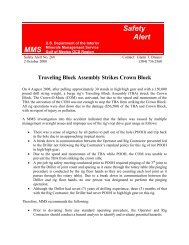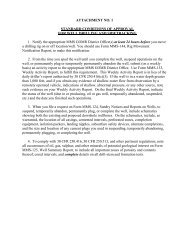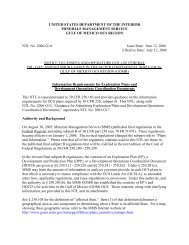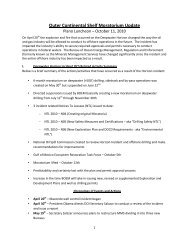Deepwater Gulf of Mexico 2004: America's Expanding ... - OCS BBS
Deepwater Gulf of Mexico 2004: America's Expanding ... - OCS BBS
Deepwater Gulf of Mexico 2004: America's Expanding ... - OCS BBS
- No tags were found...
Create successful ePaper yourself
Turn your PDF publications into a flip-book with our unique Google optimized e-Paper software.
A predominant workhorse <strong>of</strong> the GOM is the spar. A spar is a vessel with a circular cross-section that sits<br />
vertically in the water and is supported by buoyancy chambers (hard tanks) at the top, a flooded midsection<br />
structure hanging from the hard tanks, and a stabilizing keel section at the bottom. Some unique<br />
features <strong>of</strong> a spar include<br />
• favorable motion characteristics compared with other floating systems,<br />
• stability (the center <strong>of</strong> buoyancy is above the center <strong>of</strong> gravity),<br />
• cost insensitivity to water depth, and<br />
• water-depth capability up to 10,000 ft (3,048 m) and beyond.<br />
A spar is held in place by a catenary mooring system, providing lateral stability. Currently, there are<br />
three competing versions <strong>of</strong> spars used in the GOM: classic spar, truss spar, and cell spar (figure 43).<br />
The first generation <strong>of</strong> spar design is the classic spar. It is made up <strong>of</strong> one cylindrical hull that extends to<br />
the bottom <strong>of</strong> the structure and surrounds a center opening. This opening allows the wellhead to be on the<br />
platform and permits both drilling and production operations. Approximately 90 percent <strong>of</strong> the classic<br />
spar’s hull is underwater. The first classic spar was installed in 1996 in 1,935 ft (590 m) <strong>of</strong> water in the<br />
Neptune field. Other examples <strong>of</strong> a classic spar are Genesis and Hoover.<br />
The second generation <strong>of</strong> spar design is the truss spar. In this design, a truss structure (similar to the<br />
space frames used in conventional fixed platforms) replaces the lower portion <strong>of</strong> the cylindrical hull used<br />
in the classic spar. The truss section is lighter than the equivalent cylindrical section <strong>of</strong> the classic design,<br />
providing the following advantages:<br />
• construction costs are lower than a classic spar <strong>of</strong> similar size,<br />
• width <strong>of</strong> the center opening can be increased to accommodate additional wells, and<br />
• topside equipment can be expanded to handle additional production.<br />
In 2001, the first truss spar was installed over the Nansen field in 3,680 ft (1,122 m) <strong>of</strong> water. Other<br />
examples <strong>of</strong> the truss spar are Boomvang, Horn Mountain, and Devil’s Tower. Once installed, Devil’s<br />
Tower will be the deepest spar, operating at a water depth <strong>of</strong> 5,610 ft (1,710m).<br />
The third generation <strong>of</strong> spar design is the cell spar. The cell spar’s hull is made up <strong>of</strong> several identically<br />
sized cylinders surrounding a center cylinder. The main advantages <strong>of</strong> the cell spar design are reduced<br />
fabrication and transportation costs. The tank <strong>of</strong> a classic or truss spar requires specialized shipyard<br />
fabrication (large-diameter, steel-plate rolling machines are required). To date, all classic and truss spars<br />
have been constructed in European and Far East shipyards and require transport to the GOM. In contrast,<br />
each cylinder <strong>of</strong> the cell spar, being <strong>of</strong> a smaller diameter, can be fabricated using rolling machines that<br />
are readily available in most U.S. shipyards. Once fabricated, the cylinders are then lined up and welded<br />
together. This entire process can be done in the United States, increasing the number <strong>of</strong> contractors<br />
available for bidding purposes and reducing transportation costs. The main disadvantage is that the cell<br />
spar has no center opening for surface wellheads so only subsea well production is possible. The first cell<br />
spar will be installed in the Red Hawk field in 5,300 ft (1,615 m) <strong>of</strong> water in late <strong>2004</strong>.<br />
Figure 44 shows the different types <strong>of</strong> production systems installed each year. Data values can be found<br />
in Appendix F. At least eight deepwater production facilities (primarily truss spars) are under<br />
construction or pending installation at this time.<br />
67







